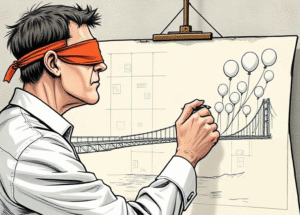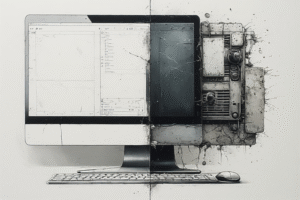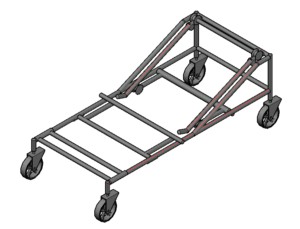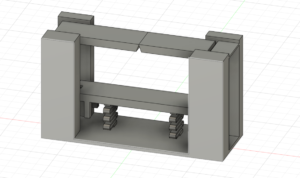Designing something that makes a meaningful impact in its field—and stays relevant long after its initial application—is always a challenge. Depending on how fast the industry evolves, some forward-thinking ideas can push things ahead, while others might be phased out shortly after they appear. Predicting what technologies will stand the test of time is difficult, especially since we’re limited by the knowledge available and preconceptions we have today. We can’t fully anticipate what breakthroughs or shifts in scientific understanding might emerge down the line and reshape the landscape entirely.
That said, this uncertainty is part of the natural trial-and-error cycle that drives innovation. While it’s true that this iteration is essential, it doesn’t mean these quickly phased out technologies should be dismissed without reflection. In fact, understanding why certain ideas faded can offer valuable insight—insight that can guide future designs toward greater chance at relevance and longevity.
For now, lets review a few of these examples and pick out some general reasons why theses phase outs happened and form the learnings into some questions engineers can ask themselves which could help conceive a long lasting design.
Early and Traditional Examples
Atmospheric Railway
In the 1840s, steam locomotion was emerging as a dominant mode of transport. However, as its use became more widespread, its limitations also became increasingly apparent — particularly the lack of power and traction. Steam locomotives often struggled to climb steep gradients, making it difficult to install railways in hilly regions. One such challenge arose in Dalkey, Ireland, where the terrain presented a significant obstacle. To address this, engineers devised and tested a new concept: the atmospheric railway.
Atmospheric railways operated using a combination of vacuum and air pressure. At the center of the track lay a sealed cast iron pipe, inside which a piston was housed. This piston was connected to the underside of the train by a vertical rod that passed through a continuous slot along the top of the pipe. Stationary pumping stations, spaced at intervals along the line, created a vacuum within the pipe ahead of the piston. The resulting difference in pressure caused atmospheric air behind the piston to push it — and the attached train — forward. To maintain the vacuum, the slot was sealed with leather flaps that opened only as the train passed.
The concept was put into practical use in England with the construction of a roughly 13-mile atmospheric railway, featuring large engine houses spaced every three miles. Although the technology was innovative for its time, it proved costly to maintain — particularly due to the constant upkeep required for the leather seals. Additionally, the system’s performance was limited by the spacing of the pumping stations, which restricted the train’s speed and efficiency. As a result of these challenges, the line was discontinued in 1848. Today, three of the original engine houses remain as lasting reminders of a once-promising technology that was expected to become the primary power source for railways.
Airships and the Empire State Building
The first rigid framed airship, or Zeppelin, first set off in 1900 and marked a golden age of airship use, with their most prominent use lasting between the 1910’s to the 1930’s. During these decades, it was seemingly apparent that airships would dominate the skies as the primary transportation method of the future. As such, some areas of engineering decided to take steps in accommodating airship use based of the preconception that airships would be widely used in the future. One example of this is the ‘Empire State Building’, with some of the features that was built into it’s overall design.
Completed in 1931, the Empire State Building was the tallest building in the worlds at it’s time. It was built with a unique shape, having a long spire that rose form it’s roof up to its total height of 1454 feet (443 meters). That spire wasn’t built into the building just for aesthetics and notoriety, but was intended to be used as a mooring mast for dirigibles (rigid airships like zeppelins). Trans Atlantic airships would be capable of docking with the building, in which passengers could disembark directly into the building via an elevator down the spire. The first attempted docking though, was unsuccessful, only lasting for a few minutes due to high wind turbulences, and deeming the whole process to be incredibly dangerous. Within the decade after the attempt, in 1937, the famous Hindenburg crash took place, quickly ceasing all major uses of airships, which were then quickly surpassed by the continuing advancing airplanes, rising above airships as the more practical and safer form of air travel. This characteristic built into the Empire State Building is an interesting relic from the preconceived notions of future prominent airship use.
Recent and Modern Examples
While the older examples of futuristic concepts missing the mark may seem to be more unorthodox ideas that make for compelling stories, there are numerous modern real-world cases where attempts to implement new designs and technology have similarly fallen short – especially comparing to other more practical methods that ended up performing the same function. As reviewing these more recent examples, you may find that some of them may still be in production, but have fallen vastly to the wayside form their original conception.
Smart Fridges
In an effort to modernize kitchen appliances, manufacturers began adding smart screens to standard refrigerator doors. These screens functioned like internet-connected tablets, designed to help users manage food inventory, recipes, and shopping lists. In the 2000s, this innovation was seen as practical and even predicted to set a trend for other appliances. However, several issues emerged that ultimately hindered its success.
Smart fridges gained a reputation for being expensive, slow, and poorly supported—often lacking regular updates and requiring costly maintenance just a few years after purchase. Meanwhile, smartphones were already widely owned, continually improving, and far more practical. As a result, engineers shifted their focus to developing apps for smartphones that could perform the same functions more efficiently and affordably than smart fridges ever could.
Smart fridges are still available today, but their popularity has declined since their early days. With more practical and cost-effective alternatives available, their value is increasingly questioned. Seemingly, consumers now prefer using smartphones for the same function while providing more flexibility.
Google Glass (2014)
An early version of smart glasses, Google Glass featured a single display lens positioned over the right eye, delivering real-time information to the user. It could perform tasks like taking photos, providing directions, translating speech, and more. The device included a built-in camera, a touchpad on the side, voice control, Wi-Fi, and Bluetooth connectivity. Despite its advanced features and the growing interest in wearable technology, it failed to gain mainstream traction. Launched in 2014, it was pulled from the consumer market by 2015.
Its fall from relevance was due to several factors, including limited battery life, widespread privacy concerns about wearing a camera at all times, and a misreading of the market. The high price point targeted a niche, high-end audience, which created a confusing and unappealing image for the average consumer. t struggled to compete with other products that offered better cameras and more functionality at a lower price, ultimately leading to its failure.
Why do these Promising Concepts Phase out?
Understanding why certain technologies disappear is much easier in hindsight, when the causes can often be clearly traced. But during the moment, as events are still unfolding, the picture is usually far more complex. In some cases, it’s not as simple as saying “the technology became outdated.” Many technologies or engineering practices that eventually get replaced still enjoy a decent run before being phased out. What’s more intriguing are the ones that vanish relatively quickly afetr they appear. These developments that didn’t get their lengthy time to shine could simply be a victim to the regular process of ‘Technological stepping stones’. Sometimes it’s unavoidable as things just need to be tested in real world settings to verify it’s viability.
While the specific reasons can vary depending on the context, there are some overarching factors that explain why engineering concepts and technologies—intending to remain around for a long time—end up being phased out quickly.
The new concept doesn’t actually perform better than current methods
You may have heard about emerging technologies lauded as the next big thing that will revolutionize everyday life and solve the problems of current methods. While some of these technologies offer similar services, their actual performance is often impractical and fails to surpass that of existing solutions. An example of this was the conceptualizing of Solar railways. The promise of embedding solar panels into roads would be a better method to electric vehicle charging over traditional solar panel farms or rooftop installations. However, road embedded solar panels are costly, costly to maintain and do not outperform the traditional placements of solar panels.
Misunderstanding the economic viability
New and promising technologies often appear to be the way forward—until it’s realized that they’re not economically viable. The issues can range from high production costs to a lack of consumer demand needed to sustain their popularity. This can also happen with trendy modern technologies that, despite their popularity, are forced into industries where they aren’t actually needed. An interesting example of this was in real estate by attempt at using VR heads for property viewings. This didn’t take off because eager home owners wanted to view homes in person.
Real problem has not been identified/ Not a reliable solution
Designing and engineering a solution often involves numerous micro-iterations and conceptual explorations aimed at finding the most effective approach. However, if insufficient time is spent understanding the actual problem, the entire development process can produce a solution that ultimately fails to meet user needs. A broad example of this in transportation engineering is urban highway expansion. In attempts to reduce traffic congestion, adding more lanes may seem logical—but in reality, it often leads to induced demand, worsening the problem. Instead of focusing solely on reducing congestion, the real issue may lie in over-reliance on road infrastructure. A more effective solution might involve improving urban planning and investing in reliable public transit systems.
The nature of differing industries
Specific solutions are typically tailored to specific niches or industries where they are most likely to be applied. Some industries are highly receptive to new ideas, often experiencing a surge of innovative concepts—though many of these ultimately fail, with only a few gaining lasting traction. In contrast, other industries tend to be more conservative, favoring gradual change and relying on proven methods rather than embracing rapidly evolving or untested solutions. Robotics engineering is a rapidly evolving field that frequently produces new ideas and applications—some of which gain traction, while many remain as experimental concepts. In contrast, structural engineering tends to progress more slowly, relying heavily on well-established methods. New approaches in this field are often treated as theoretical or conceptual, with few advancing to widespread adoption.
Political Landscape
Depending on how a country is governed, certain technologies may be favored and actively promoted, while others are discouraged or deprioritized. Political factors—such as shifting alliances, rivalries, or changes in leadership—can also influence how a technology is perceived. A technology once considered acceptable or promising can quickly fall out of favor or even become obsolete due to changing political agendas or international tensions. An example of this in civil engineering is the rapid construction of nuclear bunkers during the Cold War. At the time, they were seen as essential, but as tensions eased and satellite monitoring advanced, their strategic value diminished. Many of these bunkers were soon rendered obsolete, and today, most are either abandoned or repurposed for other uses.
Safety Concerns
Before a product is introduced for everyday consumer use, it typically undergoes a series of tests—ranging from ease of use to more rigorous safety evaluations. While many issues are addressed during development, some minor inconveniences may be overlooked. However, there are cases where unforeseen problems slip through and only become apparent once the product reaches consumers. If these hidden issues are later deemed unsafe, the product may be quickly pulled from the market, often through a recall. An example of this is by the Samsung Galaxy Note 7, which had defect in the battery that would cause it overheat, catch fire and explode. Attempts were made to fix the issue, but the device was ultimately discontinued.
Good questions to ask for preventing a phased out design
It’s all great to talk about how these examples happened after the fact, but what can we take away from this? How can we pull some learnings from this to aide us in designing and engineering things that are resilient to quick phase outs and rather, remain for some time with relevancy? Obviously, no one wants to be on the end of developing something that doesn’t get accepted by the masses, or fails to meet it’s intended utility. Unfortunately, there isn’t much that can prevent this indefinitely, but asking ourselves a series of questions that can help apply to the design and maybe find some issues that can be mitigated before it’s implementation.
What were some negative things that occurred to similar designs in the past?
Build your knowledge! Research other situations where failures became relevant in similar things that you are working on. What were their downfalls, and what were the responses to fixing the causes?
Has the true problem been identified?
Even if a problem appears to be clearly defined—or if a client requests a specific design—it’s important to gather as much relevant information as possible and take time to fully understand the context behind why they are asking you for your services. Ask yourself: What circumstances led the client to seek your services? Is the fix they’re asking from you going to remain sound or is there an underlying factor with require similar repairs in the near future?
What is the likelihood that this design will need to be revised due to technological changes?
Are you in an industry that doesn’t change very often? Fields that are changing regularly to incorporate the newest technologies are ones like robotics, renewable energy, and even AI. Some industries that change very slowly are civil engineering, geotechnical, traditional mechanical engineering, (gears, hvac, manufacturing machinery). Someone working in a conservative field can be safer to phase outs, but those in rapidly changing field will have to be more attentive to what technologies is taking hold
How much will other industries have to accommodate to make this new idea practical?
Several ideas can appear to be revolutionary in a vacuum, but be assured that other industries will have to be accommodated with the workings of your design in some way. If everyone else has to make less changes, or not change at all, then it’s likely to be a good idea that will stick. But if everyone else must change extensively for your idea to be practical, then there’s a possibility that it doesn’t meet real economical expectations, thus, being phased out quickly.
How long will the development time be?
Consider the length of development time. If you’re working in an industry where practices evolve rapidly, spending too long in development can end up hurting the relevance of your solution. Even if your design eventually reaches completion, by the time it does, newer technologies may already be in the research phase—putting forward fresh ideas that your now-outdated concept will have to compete against.
Are there ways to accommodate future changes to the design?
Design often comes with limitations that can constrain your ability to achieve the best outcomes, even if you know those constraints don’t make logical sense to follow. When faced with these restrictions, one effective approach is to plan for future expansion. This could mean designing with modularity in mind or including extra materials and components at potential extension points to allow for flexibility in possible expansions. Essentially, the goal is to create a design that not only meets current needs but can also evolve—making it easier to integrate newer solutions if the original design becomes outdated.
Concluding
While predicting lasting impact is tough, each phased-out idea offers lessons. By understanding why some designs fade, we can ask better questions—and build with greater foresight. If you have enjoyed this article, leave a comment and start the conversation.






